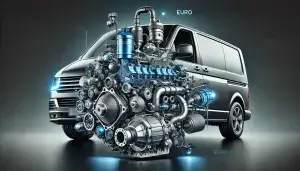Latest Technologies
The transition from Euro 5 to Euro 6 standards has driven significant technological advancements in emission control systems. This blog post will explore the latest innovations that make these conversions possible and effective.
Advanced Emission Control Systems
Selective Catalytic Reduction (SCR)
- Function: SCR systems inject a urea-based solution into the exhaust stream, converting NOx into nitrogen and water.
- Advancements: Modern SCR systems are more efficient and compact, making them suitable for a wider range of vehicles.
Diesel Particulate Filters (DPF)
- Function: DPFs trap and oxidize particulate matter in the exhaust, reducing PM emissions.
- Advancements: Improved materials and designs have enhanced the durability and efficiency of DPFs, reducing the need for frequent regeneration.
Role of Software
ECU Remapping
- Function: Updating the vehicle’s Engine Control Unit (ECU) software to optimize performance and emissions.
- Advancements: Advanced algorithms and real-time data processing allow for more precise control of engine parameters, ensuring compliance with Euro 6 standards.
Real-Time Monitoring
- Function: Continuous monitoring of emission levels and system performance.
- Advancements: Integration of IoT and AI technologies enables real-time adjustments to maintain optimal emission levels under various driving conditions.
Hardware Upgrades
Catalytic Converters
- Function: Catalytic converters reduce harmful emissions by converting them into less harmful substances.
- Advancements: New materials and coatings have improved the efficiency and lifespan of catalytic converters.
Exhaust Gas Recirculation (EGR)
- Function: EGR systems recirculate a portion of the exhaust gases back into the engine, reducing NOx emissions.
- Advancements: Modern EGR systems are more effective at reducing emissions without compromising engine performance.
Future Innovations
Electric and Hybrid Technologies
- Impact: The shift towards electric and hybrid vehicles is accelerating, offering zero-emission alternatives to traditional combustion engines.
- Integration: Combining these technologies with advanced emission control systems can further reduce the environmental impact of vehicles.
Hydrogen Fuel Cells
- Impact: Hydrogen fuel cells produce electricity through a chemical reaction, emitting only water vapor.
- Potential: As infrastructure improves, hydrogen fuel cells could become a viable option for zero-emission vehicles, complementing the goals of Euro 6 and future standards.
Conclusion
Technological innovations have played a crucial role in enabling the transition from Euro 5 to Euro 6 standards. Advanced emission control systems, software updates, and hardware upgrades are essential components of successful conversions. Looking ahead, the integration of electric, hybrid, and hydrogen technologies will continue to drive progress towards even cleaner and more efficient vehicles. By staying informed about the latest developments, you can make informed decisions about upgrading your vehicle and contributing to a sustainable future.






